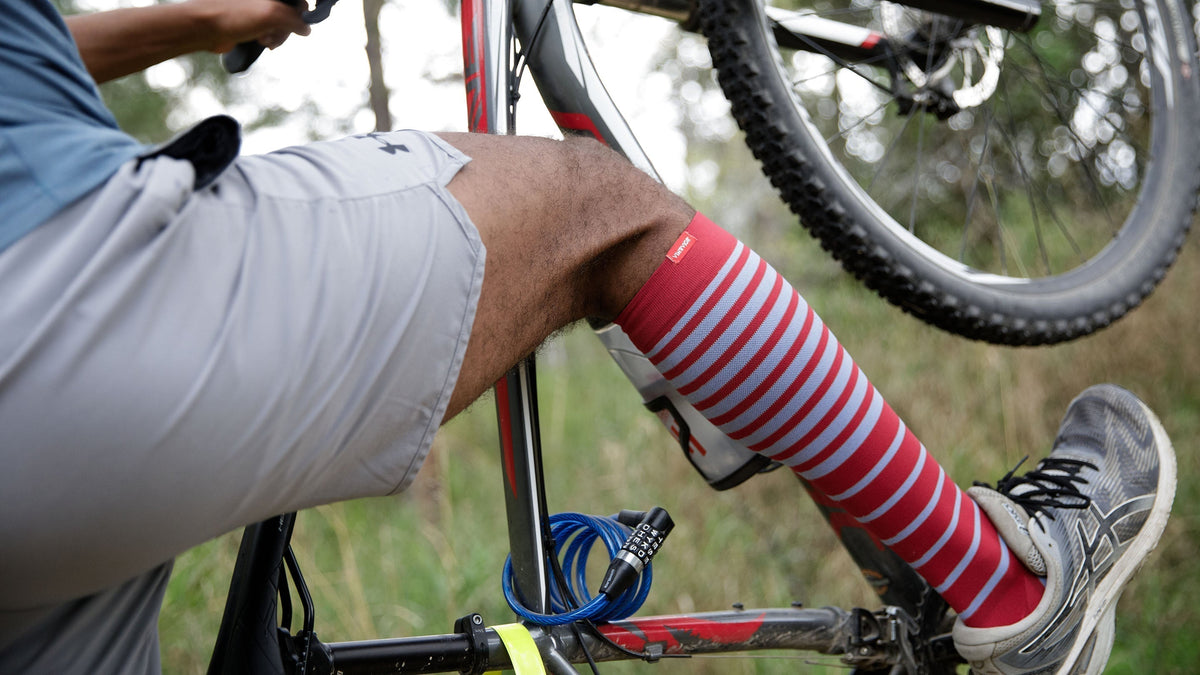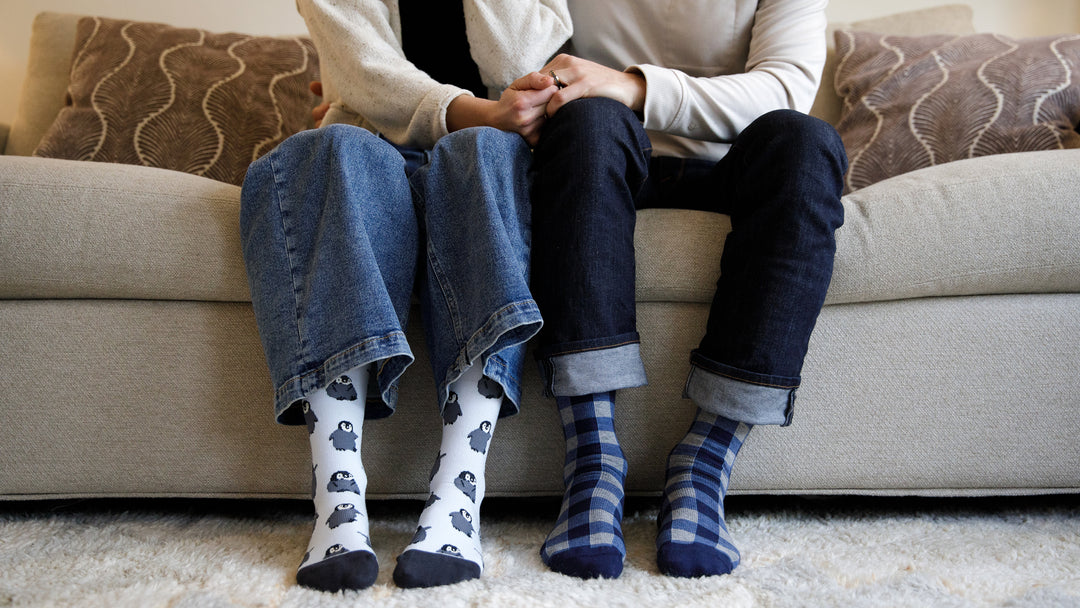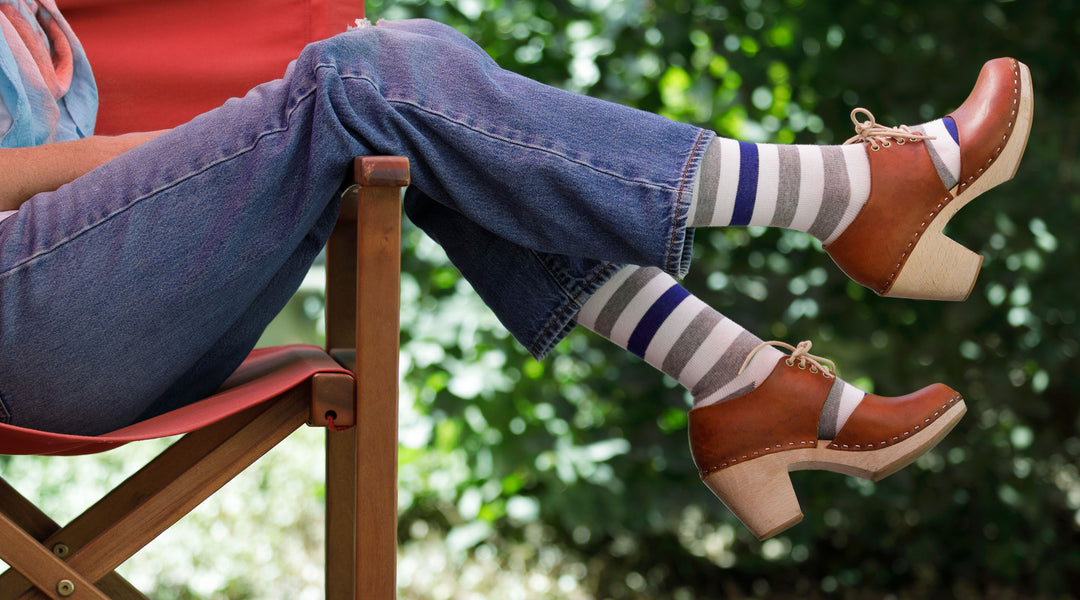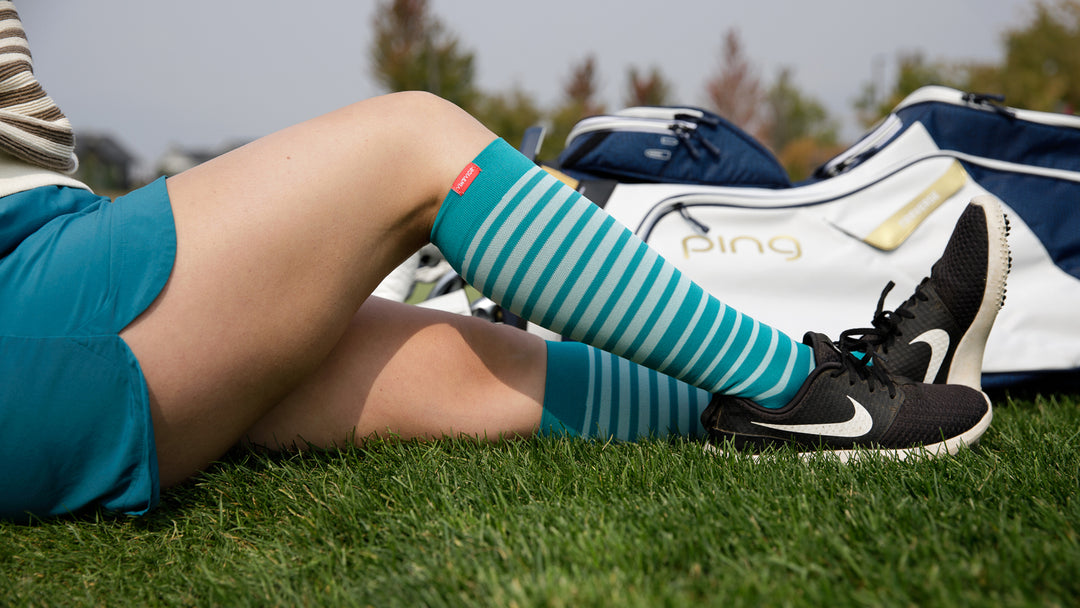

Do your arches hurt after running? Don’t worry, we have the tips you need to solve arch pain!
Pain in the arch of the foot, especially after running, is often a sign of an injury known as plantar fasciitis. The Mayo Clinic states that plantar fasciitis is an inflammation of deep tissue in the arch of your foot and is a common cause of foot or arch pain. It can occur for various reasons, from wearing the wrong shoes or simply overuse — running or walking too much without giving your body the rest it needs. You may be experiencing arch pain after running for other reasons, too. For example, if you have naturally high arches and not enough foot support, running and walking can become painful.
In this article, you will learn 13 easy and actionable tips for preventing or treating arch pain after running. Remember to listen to your body, adjust as needed, and always see a medical specialist if the pain persists.

Looking for comfort that supports your stride? Explore our athletic compression socks designed to keep runners moving comfortably.
Common Causes of Arch Pain After Running
Pain in the arch of the foot, especially after running, is often linked to plantar fasciitis - an inflammation of the deep tissue in that area. It can be caused by unsupportive footwear, your anatomy (if you have high arches), or other factors.
Overuse and Repetitive Stress
Arch pain caused by plantar fasciitis occurs when a runner overtrains. Overtraining refers to either running too much, too soon, without gradually increasing volume week after week, not getting enough rest to heal from intense sessions, or ramping up the intensity of your workouts too quickly. This is why athletes should follow a gradual training program, as well as always include warm-ups in their routines and rest days to recover effectively.
Plantar fasciitis can also be caused by overly tight calf muscles, which put pressure on the posterior chain of muscles used as you run. You can avoid this by warming up with some dynamic stretching before heading out.
High Arches or Flat Feet
According to a key scientific report, there are two anatomical features that might make your arches hurt after running. If you naturally have a high arch, then your foot may not be strong enough to support it as you land during your runs. This isn’t noticeable at first, but in time, can become quite painful. To know if you have high arches, simply check out your footsteps when you walk barefoot after a shower (with wet feet on the tiles). Can you see a gap on the inside of your feet? That’s your high arch! You can strengthen your feet to better support your high arches. Check out some exercises here.
The other feature that causes foot pain is if you have flat feet. Unlike the high arches scenario, this is a situation where your feet flatten completely when you put weight on them (so, the opposite of a high arch). People with flat feet tend to roll their ankle inwards (overpronating) when they run, which can cause ankle or knee pain. As a result of your flat feet, you may be pushing down too much with the arch of the foot when you run. Adequate arch support, such as specific shoes or podiatrist recommended insoles, can help align your ankles and feet better and take some stress off the arch of the foot.
Unsupportive or Worn-Out Running Shoes
Sometimes, arch pain can have a very simple answer: your shoes. A 2022 study found that over 80% of people don’t wear shoes that are supportive enough, which leads to arch pain.
Supportive footwear is essential for off-road running, where rocks and roots can end up hurting you as you hit the trails. But, even on the road, the repetitive stress from landing on hard surfaces can end up hurting your feet and causing arch pain. The first thing you should look out for is that the soles of your running shoes are in good condition: the lugs or outsole design will appear worn out and flattened when your shoes have outlived their purpose.
Next, try out new shoes in a specialized store. You may be able to do a gait analysis where you run on a treadmill and get recommendations depending on how your foot lands. Discuss your plans with the store assistant, as they may be able to find shoes adapted to the terrain where you’ll run.
Poor Running Form or Foot Posture
Limited ankle dorsiflexion (caused by tight calves), awkward foot posture (e.g., pointing with your toes outwards when running), overpronating… all these can be categorized as “poor running form” as they lead to biomechanics that don’t conform to a smooth, forward facing, correct movement. And they can all contribute to pain on the arch of your foot after running.
The best thing to do is to have a biomechanics specialist analyze how you move. The most accessible way to do this is the running store running gait analysis, which can often be done free of charge. Some stores will print out a visual of how you land and your key pain points and may give you advice. Alternatively, a podiatrist specialized in running will conduct a similar test and be able to make up custom orthotics to better support your feet.

Breathable support matters, especially during exercise. Check out our moisture-wick compression socks built for active lifestyles.
How to Prevent and Treat Foot Arch Pain After Running
So, how can you avoid arch pain after running? And is it easily treatable at home? We’ve gathered 13 tips from specialists to keep your feet happy and healthy.
Tip 1: Try Ice Baths to Relieve Sore Arches After Running
Ice is part of a classic at-home treatment for plantar fasciitis, the RICE method (rest, ice, compression, and elevation), which is recommended by medical research. Applying ice to the foot helps bring down the inflammation from running. You can use an ice pack for about 20 minutes or submerge your feet in a cold bath with ice cubes in it. It’s a refreshing way to end a run on a hot day, too.
Combine this with elevating the feet and then put on your favorite pair of compression socks to support and massage your lower limbs.
Tip 2: Rest and Reduce Mileage Temporarily
Rest is another element in the RICE method. It is known to be one of the best treatments for improving arch pain. In the first instance, stop running and take pressure off the feet by elevating the legs. This also helps boost blood flow from the legs back to the heart, which will reduce inflammation.
If you want to return to running, you should do so very gradually and only when the arches of the feet feel fine when walking for short periods of time. If you continue to run while in pain, you may injure yourself further. Severe arch pain or plantar fasciitis may take from 6 to 18 weeks to heal.
So, when returning to running, we recommend using a run-walk protocol, whereby you go out on 20-minute sessions where you walk for 3 minutes, run for 1 minute, repeatedly. Then, you can increase the time you run at every session, until you’re running for 20 minutes. Slowly build up from here.

Browse our moisture-wicking nylon compression socks, ideal for runners in all conditions.
Tip 3: Wear Supportive, Properly Fitted Running Shoes
Supportive shoes and socks are the basis of healthy feet for runners, and you need to understand what best fits your feet and running style. Research shows that supportive running shoes reduce your risk of injury, when compared to barefoot or minimal shoes.
For example, if you log many miles on roads, then you’ll need shoes that provide the right level of cushion to protect your feet and joints when you land repeatedly on hard surfaces. Microtraumas are caused in your muscles and joints when you run on the road, according to the 2nd edition of Orthopaedic Physical Therapy Secrets. So, the more you run, the more you should consider ways to relieve the pressure you put on your body.
If you prefer to run on trails, you’ll need shoes with protective design features. Good trail running shoes cushion and protect your feet from hitting rocks and trail debris. They can have a better hold on your foot, while also providing arch support.
Try on different pairs of shoes at your local store and compare models and designs. If you can get a gait analysis in-store, you’ll be able to get a more personalized recommendation and improve your running form.
And, whichever shoes you choose, wear them indoors first (even better if you can test them on a treadmill). That way, you can return them if you feel that they’re either not supportive enough, or if they are hindering you when you’re running for a little longer.
Tip 4: Add Arch-Supporting Insoles or Orthotics
If your arch pain is caused by overpronation and/or high arches, you can benefit from support from some specialized insoles. Many are available in running stores, so feel free to experiment with off-the-counter ones to see if they offer any relief.
However, if you keep having sore arches after running, consult with a podiatrist. They can assess your running form and your shoes to give you a holistic answer to your problems. They can also design custom orthotics to support your feet where they need it.
Tip 5: Stretch Your Calves and Plantar Fascia
As we’ve mentioned above, poor ankle mobility, particularly the dorsiflexion, can cause pain in the arch of the foot and even plantar fasciitis. Often, the ankles get stiffer because of tight calf muscles. To avoid this, include some calf raises in your dynamic warm-ups and in your strength training sessions. Ensure you stretch your calf muscles regularly, either after a run or during a separate mobility session.
The same goes for the plantar fascia, i.e. the sole of your foot. A simple search for foot stretches will pop up a few options. You can also use a tennis ball to massage the foot, rolling it gently in all directions. Vary the movement (and the stretch) by pointing your toes for one round of stretches, then flex them for another round. You’ll feel different tendons stretching, but don’t push too hard into the tennis ball. You should feel a manageable level of tension.
Tip 6: Strengthen Your Foot Muscles to Prevent Arch Pain After Running
You can also work on the strength of your foot muscles to support weaker arches or flat feet. The Mayo Clinic suggests that strengthening the foot can help you prevent arch pain caused by plantar fasciitis. Another study found that increasing ankle flexibility was seen to improve pain from plantar fasciitis. These exercises also improve the flexibility of the small tendons and muscles in the foot.
Foot strengthening exercises can include:
Working on your big toe mobility by moving it outwards, focusing on keeping the rest of the toes from moving with it.
Make a “wave” with your toes, raising them in sequence and slowly bringing them down one by one; start with the little toe for a few reps, then reverse the order.
Splay your toes out on a mat without lifting them.
Make a “short foot” by pulling the toes back towards your heel, trying not to scrunch them (so the work is done by the middle part of your foot); you will move very little at first, and that’s normal!
Tip 7: Roll Out Your Arches with a Ball or Roller
Stretching your plantar fascia with a tennis ball not only helps remove tension, but it can also be a relaxing massage for the whole of the foot. Alternate between keeping your toes pointed or bent when you roll over the ball — you’ll get different sensations. A foam roller is also good, but you’ll need a smaller one so you can apply more targeted pressure on the feet (as opposed to the bigger ones you may use for larger muscle groups).
Tip 8: Improve Your Running Form to Prevent Arch Pain and Foot Injuries
Various studies tell us that good running form reduces the risk of injuries, while also improving your performance. You can have your running form assessed in specialty running shops by running on a treadmill. This will help with your choice of footwear, too, as the sales representative can decide whether you need any arch support.
To work on your running form, think of landing with your feet close to your center of gravity, as opposed to striding out far in front. An easier way to do this is to think of the foot as a tripod, with one point under the big toe, one under the little toe, and one under the heel. If you imagine yourself landing evenly on all three, you will automatically begin to move your feet closer to your center of gravity. This could reduce the impact of landing on your joints and helps you spend less time on the ground. Studies like this one found that less time spent on the ground leads to better running efficiency and fewer injuries.
Tip 9: Do a Gait Analysis with a Specialist
The best way to know exactly what aspect of your running form to work on is to have a specialist assess you as you run. This can be done in running stores where you can run on a treadmill, which allows you to also assess different types of shoes. Many stores will now conduct a full gait analysis and provide you with a 3D view of your landing patterns, potential pain points, etc.
You can also search for podiatrists with a running speciality in your area to do the same sort of testing. Finally, some physiotherapists will also provide this service.
Tip 10: Replace Worn-Out Shoes Regularly
Running shoes support your feet with specialist foams for cushioning and a series of design elements to prop up your arches or protect your feet from trail debris and other hazards. Over time, the foam loses its elasticity and softness. The structure of the shoes can be altered by the miles and the pressure from your body and the surfaces you’re landing on. All these changes reduce the support and protection from your shoes, which is why it is recommended that runners replace their shoes after a certain number of miles.
When that happens will depend on you, however. How much you wear out your shoes depends on your weight, how often you run, the type of terrain you run on, etc. We recommend checking the lugs of your shoes to see how much they’ve flattened off and inspecting your shoes to see any patterns of wear and tear. Finally, if your shoes simply don’t feel as supportive and cushioned as they used to, it’s a sign that you should replace them.
Tip 11: Use Compression Socks for Post-Run Recovery
One other key of the footwear equation is your choice of running socks. Thicker, more protective socks help prevent blisters and rubbing during long runs, but thick socks can lack breathability and may feel uncomfortable in the heat. Choosing the right material will keep your feet dry and blister-free. Merino wool is an excellent choice for this, since it allows air to circulate to your feet on hot days and keeps them warm and dry on cool days.
Good running socks also provide support to the arch of the foot and protection against blisters. This is why runners often turn to compression socks. Vim & Vigr graduated compression socks prevent blisters and play a big role in injury and fatigue prevention, as well as in recovery. They stimulate peripheral blood flow, which has been found by some studies to improve exercise performance and reduce the risk of swelling and discomfort during long runs. Moreover, the tight grip these socks have on your feet and ankles provides a welcome support to the area, including the arches of the feet.
During recovery, compression socks ensure that enough blood with oxygen and nutrients reaches your lower leg muscles. They also massage and soothe the feet and lower legs, reducing pain, swelling, and discomfort.

Tip 12: Consider Taping Techniques or Bracing
If you regularly suffer from arch pain when running, you can also tape your feet to help change the load and support the arch. Have a look at an easy at-home taping option here. Braces or splints are also helpful for some runners, particularly for wearing at night to keep a constant position for the plantar fascia and Achilles tendon. You should consult with your doctor if you’re keen to use any of these options, to ensure they’re right for your situation.
Tip 13: See a Podiatrist for Ongoing Pain
If your foot and arch pain persist, the logical next step is to consult with a podiatrist. As we mentioned above, they can assess your running gait and also look at your feet in detail and conduct any other tests that can establish the source of your problems. A podiatrist is qualified to create custom orthotics, prescribe foot strengthening exercises, and guide you towards a physiotherapist or other forms of treatment and rehab.
-----
Arch pain can go away on its own through rest, depending on the underlying cause of it. If you’ve developed plantar fasciitis, for example, you may need to rest for several months (~1.5 to 4 months). Physical therapy can also soothe your arch pain from plantar fascia while helping you regain strength and mobility in the feet.
However, for non-injury pain, such as if you’re wearing inadequate shoes, you can expect arch pain to go away as soon as you’ve switched footwear. It’s all highly personal and linked to your circumstances. So, make sure you listen to your body, follow the tips above depending on your source of pain, and consult with a doctor if the pain persists.
Ready to feel the difference compression can make? Browse our latest styles and find support that fits your routine.
References
Dugan, S. A., & Bhat, K. P. (2005). Biomechanics and analysis of running gait. Physical medicine and rehabilitation clinics of North America, 16(3), 603–621. Read it here.
Mayo Clinic Staff. (2023). Plantar fasciitis. Mayo Clinic Press. Read it here.
McNab, B., Sadler, S., Lanting, S., & Chuter, V. (2022). The relationship between foot and ankle joint flexibility measures and barefoot plantar pressures in healthy older adults: a cross-sectional study. BMC musculoskeletal disorders, 23(1), 729. Read it here.
Noriega, D. C., Cristo, Á., León, A., García-Medrano, B., Caballero-García, A., & Córdova-Martinez, A. (2022). Plantar Fasciitis in Soccer Players-A Systemic Review. International journal of environmental research and public health, 19(21), 14426. Read it here.
Nummela, A., Keränen, T., & Mikkelsson, L. O. (2007). Factors related to top running speed and economy. International journal of sports medicine, 28(8), 655–661. Read it here.
Placzek, J.D., & Boyce, D.A. (2006). Orthopaedic Physical Therapy Secrets. Hanley & Belfus Publishing.
Shashua, A., Flechter, S., Avidan, L., Ofir, D., Melayev, A., & Kalichman, L. (2015). The effect of additional ankle and midfoot mobilizations on plantar fasciitis: a randomized controlled trial. The Journal of orthopaedic and sports physical therapy, 45(4), 265–272. Read it here.
Traut, A. G., Hannigan, J. J., Ter Har, J. A., & Pollard, C. D. (2024). Influence of Footwear Selection on Youth Running Biomechanics: A Pilot Study. Sports health, 16(6), 913–919. Read it here.
Umar, H., Idrees, W., Umar, W., Khalil, A., & Rizvi, Z. A. (2022). Impact of routine footwear on foot health: A study on plantar fasciitis. Journal of family medicine and primary care, 11(7), 3851–3855. Read it here.
van den Bekerom, M. P., Struijs, P. A., Blankevoort, L., Welling, L., van Dijk, C. N., & Kerkhoffs, G. M. (2012). What is the evidence for rest, ice, compression, and elevation therapy in the treatment of ankle sprains in adults? Journal of athletic training, 47(4), 435–443. Read it here.
Warren B. L. (1990). Plantar fasciitis in runners. Treatment and prevention. Sports medicine (Auckland, N.Z.), 10(5), 338–345. Read it here.
Williams, D. S., 3rd, McClay, I. S., & Hamill, J. (2001). Arch structure and injury patterns in runners. Clinical biomechanics (Bristol, Avon), 16(4), 341–347. Read it here.
Young, C. C., Rutherford, D. S., & Niedfeldt, M. W. (2001). Treatment of plantar fasciitis. American family physician, 63(3), 467–478. Read it here.











